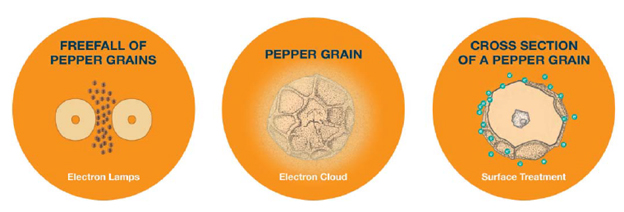Promising new techniques include high pressure treatments and applied electric fields, which can enhance shelf life and kill pathogens while maintaining a high product quality.
These were some of the key findings from the International Union of Food Science and Technology (IUFoST) workshop at Health ingredients Europe 2018. The event brought together industry experts and world-renowned scientists to present and discuss some of the latest food processing innovations capable of delivering nutritious, sustainable and safe food.
Minimal processing methods in demand
Dr Henry Jäger from the Institute of Food Technology at the University of Natural Resources and Life Sciences, Vienna opened the workshop by highlighting some key consumer trends. Consumers are increasingly looking for sustainably sourced, kitchen cupboard ingredients; products that have been gently processed; and convenience with little waste, he said. While ingredients and lifestyle are more important factors in terms of nutrition, food processing techniques can have an impact on quality and safety.

Source: "Food of the Future: Focus on Future Technologies", Henry Jäger, BOKU – Institute of Food Technology
“These techniques also have an environmental component because they can save energy when compared to conventional treatments,” said Jäger. “Although agricultural generation makes up the largest portion of food’s environmental impact, processing techniques that don’t make full use of raw materials can create waste.” Dr Jäger also pointed out that new technologies are being applied to achieve optimised agriculture, targeting crops with specific water and fertiliser requirements. Furthermore, appliance companies are working to optimise kitchen tools, enabling consumers at home to process raw ingredients in an optimal fashion.
Dr Volker Heinz from the German Institute of Food Technologies focused on protein, the demand for which is in danger of outstripping supply. The environmental footprint for beef is huge, and processed plant protein alternatives hold potential. They still face the challenge however of meeting consumer expectations of taste and texture.

Source: "Food of the Future: Focus on Future Technologies", Henry Jäger, BOKU – Institute of Food Technology
Dr Heinz discussed the possibilities of using extrusion methods on plant protein such as soy powder to achieve the fibrous texture of meat, without the need for high temperature processing. He discussed drawbacks, such as limitations on the size of batches, and outlined the findings of a recent trial that examined environmental footprints.
For this, the meat in chicken nuggets was replaced with alternatives such as dairy, wheat and insect proteins. “We found that plant-based proteins indeed have the small environmental impact, with soy-based proteins having the least impact,” he said. “What was surprising was that the footprint for lab-grown meat at the moment is very high, because of the need to use highly purified nutritional broth to feed cells.”
High Pressure Processing
Dr Carole Tonello-Samson, Commercial & Applications Director at Hiperbaric, Spain discussed the development and commercialisation of healthy foods through High Pressure Processing (HPP) at chilled temperatures. This high pressure process achieves pasteurization-like effect typically achieved by energy-intensive high-temperature techniques, and while limited batch sizes require a number of machine cycles to achieve productivity, the technology has opened up a number of manufacturing possibilities. “HPP is one solution to ensuring safety with fresher ingredients,” she explained. “Pathogen deactivation and shelf life extension without heat nor chemicals are the key benefits.”

Source: "Development and commercialisation of healthy foods throught high pressure processing (HPP) - new developments on equipment", Carole Tonello Samson, PhD Commercial & Applications Director
A good example of where HPP has been successfully applied is guacamole. The technique ensures that colour is retained and that shelf life can be extended without the need for chemicals.

Vegetable-based products like humous dips are another growing category.

In Asia, manufacturers use the technique to pack and process durian fruit, guaranteeing extended shelf life with the flavour intact. “It is easy for customers to understand the benefit of the process,” added Dr Tonello-Samson. Other potential applications include fruit and veg-based baby food, fresh meat products, additive-free ready meals and beverages.

Source: "Development and commercialisation of healthy foods throught high pressure processing (HPP) - new developments on equipment", Carole Tonello Samson, PhD Commercial & Applications Director
Low-energy electron beam
Barbora Dubovcova, a Food Safety Manager at Bühler, discussed another new processing innovation: low-energy electron beam technology (LEEB). This is another non-thermal technique, though unlike HPP it is more focused on dry foods where problems such as Salmonella and spores can sometimes be difficult to deal with, and where water should be avoided. This process should appeal to food manufacturers because they have a legal requirement to provide safe food, said Dubovcova, and because new solutions, like LEEB introduce a microbial inactivation with minimal processing and better preservation of the product quality, such as taste and nutritional value.

Source: "The future of microbial reduction for the dry food industry", Bühler UK Limited
Screening of inactivation solutions
“We were looking for non-thermal, scalable, safe technologies for dry food, and what we came up with was LEEB,” said Dubovcova. “We have proved that the concept is gentle enough to maintain product quality, yet strong to kill bacteria.” The proprietary technology, called LAATU, is designed to ensure that harmful microorganisms are deactivated before the processing journey begins.

Source: "The future of microbial reduction for the dry food industry", Bühler UK Limited
The principle of Laatu
For spices such as black pepper for example, contamination often only occurs on the surface; getting rid of bacteria without destroying the ingredient itself requires a technique that offers minimal impact. Another advantage is that the technique avoids the need to introduce water or chemicals. “The technology can be fitted anywhere along the production line and is easy and safe to operate,” said Dubovcova. “We are focusing on spices at the moment, but we’ve identified different applications as well.”


